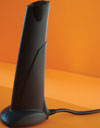

According to Poynting Antennas, many misconceptions exist with regards to the unique antenna requirements for M2M (machine to machine) communications. The first thing to consider when choosing an antenna for telemetry is whether the antenna was designed for the GSM band that is used in the countries where the meters are installed. The GSM frequency bands worldwide are either 900/1800 or 850/1900.
GSM850/1900 is used by the Americas and GSM900/1800 by the rest of the world. Poynting’s OMNI-0039-05 blade antenna has been designed to cover both these bands. Many competing products are optimised for the Americas, according to Poynting, and do not work optimally in the GSM900/1800 bands. The company invites interested parties to contact it to measure the performance of the antenna they use for their metering application.
Poynting has built up extensive expertise in this regard over the past 10 years. The OMNI-0039-05 is a lightweight, magnet mount, waterproof antenna suited to any M2M application. Its gain (including cable losses) is 1,5 dBi (±0,5 dBi) and it features VSWR across operating bands of 2:1 and linear polarisation (vertical or horizontal. According to Dr Andre Fourie, who has designed, tested and evaluated hundreds of antennas, the OMNI-0039-05 has numerous advantages:
The antenna is ground plane independent because it is a dipole instead of the more commonly used monopoles. This means that the gain, radiation pattern and matching are not dependent on the size of the ground plane on which it is mounted. This is a very nice feature because the performance of the antenna does not change depending on the mounting platform, material or the orientation at which the technician installs it.
Poynting uses a thicker cable than most antennas, which ensures lower losses, especially at higher frequencies since cable loss increases with frequency. The antenna covers all the bands of interest and also all the spectra within the bands. Fourie says many antennas the company tests do not radiate in all bands – this is clearly a problem since bands are unpredictable with different operators, in different cells and may even change in future.
Many antennas radiate in all bands but do not properly cover the transmit and receive frequencies. This may mean they work sometimes and sometimes not, since operator sub-band assignments differ and GSM uses frequency hopping; also, cellular planning means different channels are used in different cells.
Regarding gain, Fourie advises that one should never look at the gain of an indoor antenna. Gain is the result of focusing radiation. In other words it is like squashing a balloon to get more in one direction while getting less in others. Indoor antennas are not aligned by anybody and if they have high gain, there is a higher possibility of getting less signal than more, since its ‘focus’ direction is likely not where the signal comes from.
Indoor signals mostly come from reflections and unpredictable propagation routes, so one should look for something ideally with 0 dBi gain (a round balloon or an isotropic antenna). Manufacturers quoting high gain on indoor antennas are in fact misleading customers, according to Fourie, since it simply does not help. There is a big difference outdoors where the antenna is either pointed in the required direction (for directional applications) or mounted properly vertical (for omnidirectional requirements).
| Tel: | +27 12 657 0050 |
| Email: | [email protected] |
| www: | www.intetoconnect.co.za |
| Articles: | More information and articles about Inteto Connect |

© Technews Publishing (Pty) Ltd | All Rights Reserved